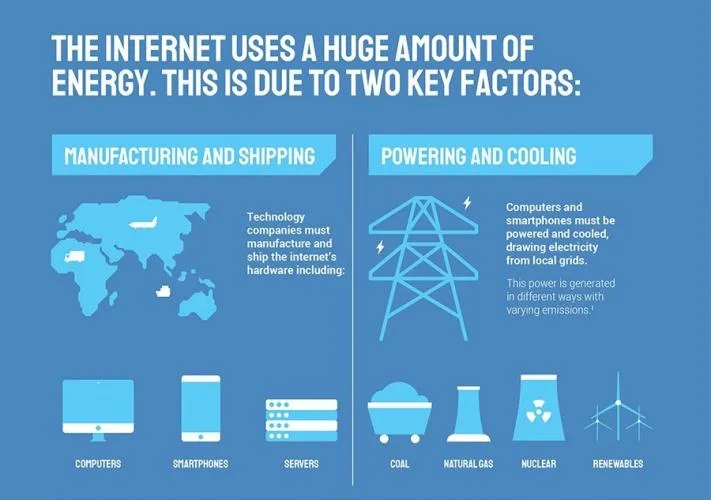Technology and the environment play an integral role in each other’s existence. The environment influences technology. People are affected by technology. The question is, how technology and the environment affect each other and how they will continue to affect each other in the future. However, its estimated that the adoption of artificial intelligence (AI) alone could lead to a 4% reduction in global GHG emissions by 2030
Technology and the environment cannot be separated. Both affect each other and each must be maintained in order for the other to be successful.
People need to be able to use technology to their advantage, this will allow them to progress and prosper. In order for technology to be successful there must be technological advancements that benefit society as a whole. A harmonious relationship between technology and the environment is essential in maintaining a technological society.
Technology and the environment complement each other. They work together in order for technology to thrive. Humans can not survive without the earth. It provides food, air, and shelter. All of these are provided through various forms of environmental quality.
How Technology Can Harm the Environment
Several technologies can harm the environment:
- Consuming resources – Valuable non-renewable resources, such as gold, are utilized in the production of technology, while others like coal are burned to generate electricity for its operation. Additionally, the manufacturing processes of technology can lead to water contamination, further depleting this precious resource.
- Pollution – Air, water, heat and noise pollution can all be caused by producing and using technology.
- Waste – Manufacturing technology creates large amounts of waste, and used electronics get thrown out.
- Disrupting ecology – Clearing land where animals used to live to build factories can greatly affect the environment’s natural cycles.
- Health hazards – The use of hazardous materials in technology production can pose serious health risks, including the potential for cancer. Moreover, excessive dependence on technology can lead to various health issues such as obesity and carpal tunnel syndrome.
Pollution affects the environment negatively. Industrialization and increasing levels of population have led to an increase in pollution due to the increased use of technology in every day life.
The pollutants produced during the process of technological advances can pollute the environment permanently if not removed. This is one of the reasons environmental history has become so important in understanding the impact of technology on the environment today.
Global warming is another possible effect of technology and the environment. A major cause of global warming is carbon emissions. Carbon emissions are the result of a technological advance such as the combustion engine.
Other forms of pollution that can be attributed to technology include nitrogen oxide from the burning of fossil fuels, and methane and chlorofluorocarbons from the manufacture of refrigerators and gas bottles. Automobile emissions rank high in this category, although there are efforts being made by automobile producers to reduce this problem.
Another effect of technology on the environment comes through the creation of environment plans or strategies. The objectives of an environment plan for human sustainability are many.
One of these objectives is to reduce the rate at which new sites for technological advancements are being developed. This objective also supports the creation of renewable land use. In addition, the reduction of the generation of harmful greenhouse gases and the encouragement of a sustainable development of the land use economy support this objective.
One way to achieve sustainable development of the environment is through technology implementation. There are many programs and projects supported by the environment plan for sustainable development.
These projects involve the use of technology in the areas of waste water management, community forestry, and carbon dioxide removal from the atmosphere. Through technology implementation, environmental problems can be addressed. It also helps to create a cleaner earth.
Today’s world faces a variety of environmental problems. Many of these problems face the poor in the developing world, those who live in rural regions, and those with little access to electricity or clean water.
It is true that technology has helped to relieve these problems in some cases. However, the type of technology used is not limited to clean energy, water purification, and improved forestry practices. There are more environmental benefits to incorporating technology into society as it pertains to technology and the environment.
Environmental advocates applaud the increased use of clean energy, water conservation, and technology implementation. They claim that technologies can and should be developed to help with the environmental problems that face society today.
While technology may not solve all environmental problems, technologies developed specifically to combat specific environmental issues such as air pollution, water pollution, and pesticides can potentially save the environment.
As indicated earlier, the environment has been affected by technology since the dawn of man. One can trace the impact technology had on the environment back to the Stone Age. Technology has continued to impact the environment in new ways as well.
Technological developments in areas such as telecommunications have created new environmental implications. A telephone network is an enormous amount of electricity generated over a very long period of time.
The energy produced by a phone network has implications for the environment that go beyond the impact it has on the individual who owns the equipment.
Technological change and its environmental impacts must be considered in today’s society. The key to a sound environmental policy is to recognise and determine the sources of technological change, and the societal responses to those changes.
It is essential that the key questions are asked, and adequate research done to evaluate the impact of technological progress on the environment.
Effective environmental policy requires flexibility and a willingness to work closely with citizens, local governments, and nongovernmental organisations to build and manage an environmental policy that advances the goals of environmental protection while protecting the environment and the sources of natural resources.
Technology Has Become an Integral Part of Our Daily Lives
Technology has become an integral part of our daily lives, from the gadgets we use to the systems that power our world. It has undoubtedly brought immense convenience, connectivity, and efficiency. However, as we embrace the benefits of technology, it is essential to recognize its impact on the environment and strive for a sustainable balance.
One of the positive aspects of technology is its potential to drive environmental solutions. Renewable energy technologies, such as solar panels and wind turbines, have gained momentum in recent years, offering clean alternatives to fossil fuels and reducing greenhouse gas emissions.
The advancements in energy storage systems and smart grid technologies have also improved the integration and management of renewable energy sources.
Additionally, technology has revolutionized the way we monitor and manage the environment. Remote sensing, data analytics, and artificial intelligence (AI) have enabled us to better understand and address environmental challenges, such as deforestation, wildlife conservation, and climate modeling.
This data-driven approach has empowered scientists, policymakers, and conservationists to make more informed decisions and take proactive measures to protect our planet.
Furthermore, technology has facilitated the transition towards a more sustainable and circular economy. The concept of the sharing economy, driven by technology platforms, has led to the rise of ride-sharing, home-sharing, and other collaborative consumption models, reducing the demand for new products and minimizing waste.
E-commerce and digitalisation have also enabled remote work options, reducing commuting and carbon emissions associated with traditional office spaces.
However, it is important to acknowledge the negative environmental impacts of technology as well. The production, use, and disposal of electronic devices contribute to the growing problem of electronic waste (e-waste), which contains hazardous materials harmful to the environment and human health.
The increasing demand for data storage and processing in data centers has also led to significant energy consumption, resulting in carbon emissions and environmental footprints.
Moreover, the rapid pace of technological advancements has created a culture of disposability, where devices are quickly replaced with newer models, leading to a throwaway mentality and contributing to the e-waste problem.
The extraction of rare earth minerals used in electronic devices often involves environmentally damaging mining practices, causing deforestation, pollution, and habitat destruction.
Another concern is the digital divide, where not everyone has equal access to technology. This can exacerbate inequalities and environmental impacts, as the production of technology devices and infrastructure often involves social and environmental injustices, such as labor exploitation and environmental degradation in low-income countries.
So, how can we strike a balance between technology and the environment?
- Promote Sustainable Design: Encouraging eco-design principles in the manufacturing of electronic devices, including energy efficiency, durability, repairability, and recyclability, can reduce their environmental impact and promote a circular economy.
- Practice Responsible Consumption: Being mindful of our consumption habits and extending the lifespan of our devices through repairs, upgrades, and proper disposal can minimize e-waste and its negative impacts.
- Embrace Renewable Energy: Supporting and adopting renewable energy technologies can reduce our dependence on fossil fuels and lower greenhouse gas emissions.
- Foster Data Efficiency: Optimizing data storage and processing in data centers, promoting cloud computing, and using AI algorithms to optimize energy usage can reduce the environmental footprint of digital technologies.
- Promote Digital Inclusion: Ensuring equitable access to technology can bridge the digital divide, promote social justice, and reduce environmental injustices associated with technology production.
- Educate and Advocate: Raising awareness, advocating for responsible technology practices, and supporting policies that prioritise environmental sustainability can create a positive impact on the relationship between technology and the environment
Digital Activies & The Carbon FootPrint
Digital technologies contribute to 4% of greenhouse gas emissions (GHG) and their energy usage is growing at a rate of 9% annually.
The internet alone is responsible for emitting 1.6 billion tons of GHG emissions each year. Furthermore, it is projected that by 2025, the communications industry will account for 20% of the world’s total electricity consumption.

Toxic Technotrash – The Looming Catastrophe
Brace yourself for the horror of technotrash! A relentless beast, born from the discarded remains of electronic devices, rampaging across our planet with unprecedented speed.
Cast aside with the regular trash, it finds its final resting place in the dreaded landfill, where its non-biodegradable materials and toxic heavy metals lurk, ready to unleash their deadly venom.
A Grim Fate – The consequences are dire as our land, water, and air fall victim to the insidious grip of technotrash. The very foundation of our sustenance is at risk as these toxic materials seep into our drinking water, contaminate our crops, and poison the creatures that roam our lands.
Nausea, diarrhea, vomiting – a mere glimpse of the horrors that await us. The looming specter of cancer looms large, casting a dark shadow over our health and well-being.
Time is Running Out – We stand at the precipice of an environmental catastrophe, as the most rapidly-growing waste stream threatens to engulf us all.
The urgency to take action is undeniable, for the devastation caused by technotrash is all too real. Let us rise to the challenge, before it’s too late, and save our planet from this monstrous menace!
The Backbone Of A Net-Zero Emissions Future
The importance of transitioning to a net-zero economy on a global scale, with a strong focus on reducing greenhouse gas emissions, cannot be overstated.
As a significant driver of economic growth and a major source of emissions, the industrial sector holds a unique responsibility and opportunity to lead in this process.
While efforts have understandably been concentrated on the energy and petrochemical sectors, it is crucial for all industries to undergo decarbonization.
At the forefront of this transition will be digital technologies, which play a pivotal role in achieving net-zero emissions. Through their capacity to process data efficiently, quickly identify issues, and virtually test solutions, digital technologies enable decarbonization efforts.
Energy-intensive systems stand to benefit from the adoption of digital and Web3 technologies, such as cloud and edge computing, artificial intelligence (AI) and machine learning (ML), internet of things (IoT) sensors, and blockchain technology, as they offer opportunities for improved efficiency and sustainability.
The significance of digital technologies in relation to greenhouse gas (GHG) emissions is becoming increasingly apparent, with emerging data highlighting their potential impact.
According to the World Economic Forum (WEF) and Accenture, digital technologies have the potential to reduce emissions by 4% to 10% in the energy, materials, and mobility sectors by 2030.
Additionally, PwC estimates that the adoption of artificial intelligence (AI) alone could lead to a 4% reduction in global GHG emissions by 2030, while Capgemini reports that the climate potential of AI could reach 16% across various sectors.
Despite the proven benefits of these technologies, however, there seems to be a lack of urgency among organisations to adopt them and accelerate decarbonization efforts.
Many industry leaders prioritise digital transformation with partners, while energy transition takes a back seat. Digital and sustainability leaders often adopt a cautious approach to technology, citing reasons such as solution immaturity, the need for further study or customisation, and challenges like intermittent renewable energy supplies and lack of trust in existing carbon trading schemes.
This conservative approach to digital technologies fails to address the pressing challenges at hand and may hinder progress towards emission reduction goals.
It is crucial for organisations to recognise the potential of digital technologies as a powerful tool in combating climate change and take proactive steps towards their adoption for effective decarbonization strategies.
In conclusion, technology and the environment are intricately connected. While technology has the potential to drive environmental solutions and promote sustainability, it also has negative impacts that need to be addressed.







